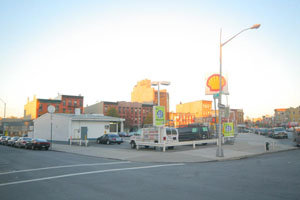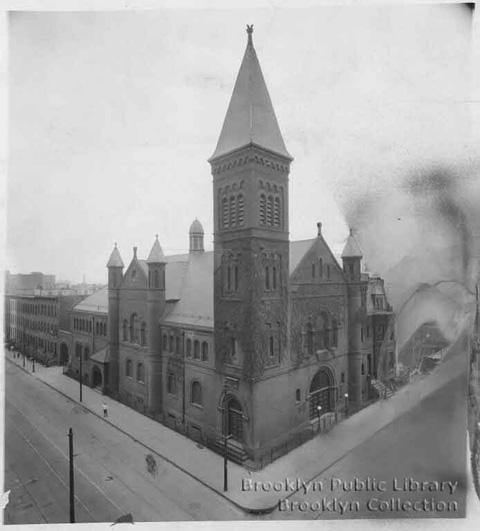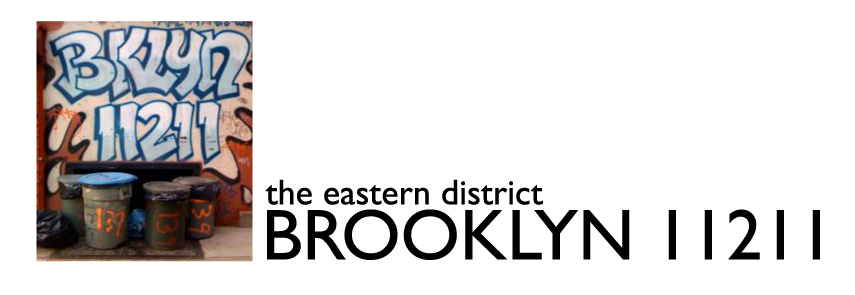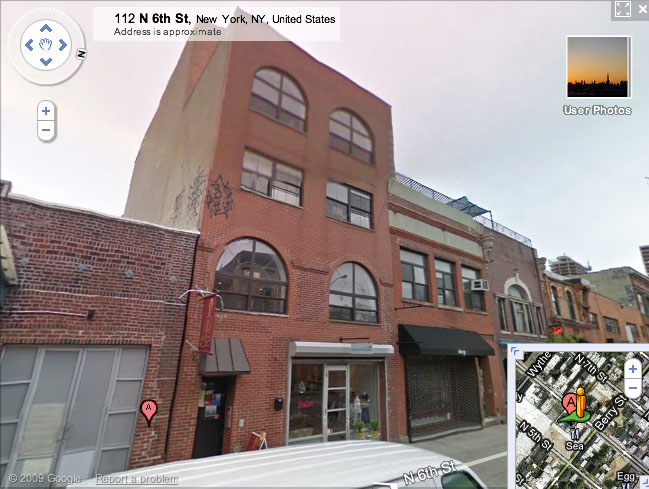Waiting for Godot at Greenpoint Hospital. It’s been three years since the RFP was issued, and – good news! – HPD is “still on pace to choose a developer for the site in the near future”. That’s reassuring.
Greenpoint Hospital: The Neighborhood is Watching
Doing the iPad Math
Seventeen paragraphs into a story on why consumers might not buy the iPad, we learn this:
It may be too early to gauge consumer interest in the iPad. Developers have not yet had time to prepare a variety of applications for the device, and Apple has not yet done much of what it perhaps does best: advertise.
Yes, that and the fact that there is no consumer on the face of the planet who has touched an iPad.
Stunningly stupid reportage.
Retail and Housing Complex Coming to Williamsburg – Or Maybe Not

351 South 1st Street in its gas station days
Photo: PropertyShark (via RealDeal)
Brownstoner reported earlier this week on the potential development of the former Shell station on the four-sided triangle at Grand, Keap, South 1st and Borinquen. The developers of the property are saying that they will build a two-story “retail strip center” in phase one and an “apartment tower” in a future phase.
In the old days, a two-story retail strip center would be called a taxpayer – those one- and two-story retail buildings that you see throughout the city, particularly from the 1930s through 1950s. They are a way for developers to put a property to some use and at least cover the costs of carrying a property until better times come along (and from the neighborhood’s point of view, that is a big improvement over a vacant lot or an abandoned gas station).
At this point, though, DOB permits have been pulled for demolishing the former gas station on the site. There are no applications listed on BIS for building anything – retail strip or apartment building. And according to the comment thread on this Real Deal posting, the developers are strapped for cash and don’t even own the property (they have a net lease).
So the near-term potential sure looks good for this turning from an abandoned gas station to a vacant lot.
July 31: Nas & Damian Marley at Second OSA Benefit
Earlier this week, OSA Presents announced its second benefit concert for the summer season – Nas and Damian Marley on July 31st. Tickets are $40 (with proceeds benefitting the Open Space Alliance for North Brooklyn). There was an internet “presale” yesterday, and tickets go on sale to the general public at noon today (click on title link, above, to go to Ticketmaster site).
Zip112 Closes Down
In a prophylactic move, Zip112, the “legal” hostel at 112 North 6th Street has decided to close its doors before the city DOB inspectors return and potentially close it down for good.
Zip112 was spared from closure during the city’s initial inspection when the owner was able to convince a city inspector that a ladder hung off the 5th floor wooden deck constituted a second means of egress. Think about that – a fifth-floor walk-up apartment with no CO for residential use was deemed legal because there was a ladder – not a fire escape, a ladder – leading from a wooden (i.e., combustible) deck. That was their second means of egress?
Maybe someone should speak to that inspector?
Montagues and Capulets of Brooklyn Development
The Observer’s Eliot Brown has an article out today about the warring factions on either side of the Rose Plaza rezoning. The basic thesis of the article is that the objections to the rezoning are all about politics and nothing about land use – that developer Isack Rosenberg just wants “to do the same to his waterfront land” as other developers have done elsewhere.
If Brown had done his homework, he’d know that the community has a pretty strong record of not supporting developers who want do the same as everyone else.
Rose Plaza proposes 801 units of housing, 160 (20%) of which would be affordable. Brown cites four projects in his opening paragraph that are relevant precedents. Two of these – Schaefer Landing and Domino – have (or propose) much higher levels of affordable housing (40% and 30%, respectively). The community supported Schaefer and supported the level of affordability at Domino (the objections to Domino were on other fronts). The two other projects cited by Brown – the Edge and Northside Piers – are more comparable to Rose Plaza, in that they only have 20% affordable housing. But the community voted against that rezoning, in large part because 20% was seen as too low.
Brown also cites “concerns about overwhelming the neighborhood” as another reason for opposition, but that was not a basis for the community board’s opposition to Rose Plaza. In fact, it was the board’s position that the base zoning (801 units) was acceptable, but that additional affordable housing was warranted because the developer was looking for a raft of special permits on top of the zoning change.
The community has been pretty consistent on this – give us smart, sustainable and manageable growth and sufficient affordable housing. Yes, there is political intrigue within the Hasidic community, but there is also hell of a lot of support for good growth.
St. Paul’s on Path to Landmark Designation

Aerial view of St. Paul’s Evangelical Lutheran Church
The Sunday School is the to the left in the photo and the rectory to the right
Photo: Brooklyn Public Library
Last week, the Landmarks Preservation Commission held one of its designation hearing days. The day included public hearings for two Coney Island landmarks, the Shore Theatre and Childs Restaurant. The Commission calendared St. Paul’s Evangelical Lutheran Church for a future public hearing, the first step in the designation process*.
LPC also took the final step and designated four new landmarks last week [pdf], including the former Germania Fire Insurance Company on the Bowery. The Lower East Side and East Village was once home to Kleindeutschland, the largest largest German immigrant neighborhood in greater New York City. The second-largest German immigrant neighborhood was, of course, Williamsburg and Bushwick.
*Disclosure: I did the initial research on the history of the church and worked with the congregation to get funding for a condition survey and restoration work.
112 North 6th Street Followup
In the Brooklyn Paper, Aaron Short has this quote from one of the few legal tenants in the building:
“It’s horrible!” said Ralph De La Rosa of Go Yoga, which occupies a first-floor business space. “The city should be doing something else instead of vacating them in this way.”
Let’s review, shall we. This is a six-story building with 12 “apartments”. There are no sprinklers (as is required for hotels and other transient uses), there are no secondary means of egress (as is required for hotels and other transient uses). Most of the four-story addition is constructed of combustible wood framing. All of the DOB permits for this building describe a three-story commercial building, so the top three stories seem to be some form of immaculate construction (DOB issued a violation for the construction of the third story in 2002, but somehow missed the fourth, fifth and sixth). There is no certificate of occupancy (so technically, even Go Yoga is in there illegally).
What else, exactly, would you have the city do? Other than the fact that a lot of people are out of their (very expensive) home, what is horrible about this whole episode is the fact that the city didn’t do something about it eight years ago.
Illegal Hostel at 112 North 6th Closed Down
There seems to be a trend developing. Just the other day, Miss Heather reported on a potentially illegal hostel operating (or about to operate) out of a former glove factory at 300 Graham Avenue. A few minutes ago, I received a press release from Assemblyman Joe Lentol’s office saying that another illegal hostel – this one operating at 112 North 6th Street – had been closed down and vacated by the Department of Buildings. According to Lentol’s office, the six apartments in the building were being used to house up to 16 “guests” each – for a potential capacity of 192 people.
A few things to note here. First, this is not a new trend. There have been reports of condos and apartments operating as hostels, B&Bs, hotels, etc. for a few years now. It is a sign of the times, as owners find themselves unable to sell condos. But given the level of rents in the neighborhood, it is also a sign of greed.
Second, there is a reason why DOB should be cracking down on this. Apartments are not built to the same code as transient hotels. Hotels require more fire protection and, importantly, more and better marked egress. Putting 192 transient residents into a non-fireproof building designed for 20 or 30 residents at the most is a recipe for disaster.
Third, having spent many an afternoon at Sweetwater Tavern watching the “conversion” of this building from a two-story commercial structure to it’s current state, the fact that there something fishy going on here is the least surprising news in the neighborhood. (The most surprising news is that this building is still standing.) A cursory look at the DOB records shows that this building has no CO, and that the conversion (started in 1998) wasn’t even for residential use. In other words, it is not legal for anyone to be living here.
UPDATE: Miss Heather has a lot more details, including screen shots of the advertising for the hostel (note that the picture they use to advertise themselves is not 112 North 6th Street).
I’m Only a Bill


